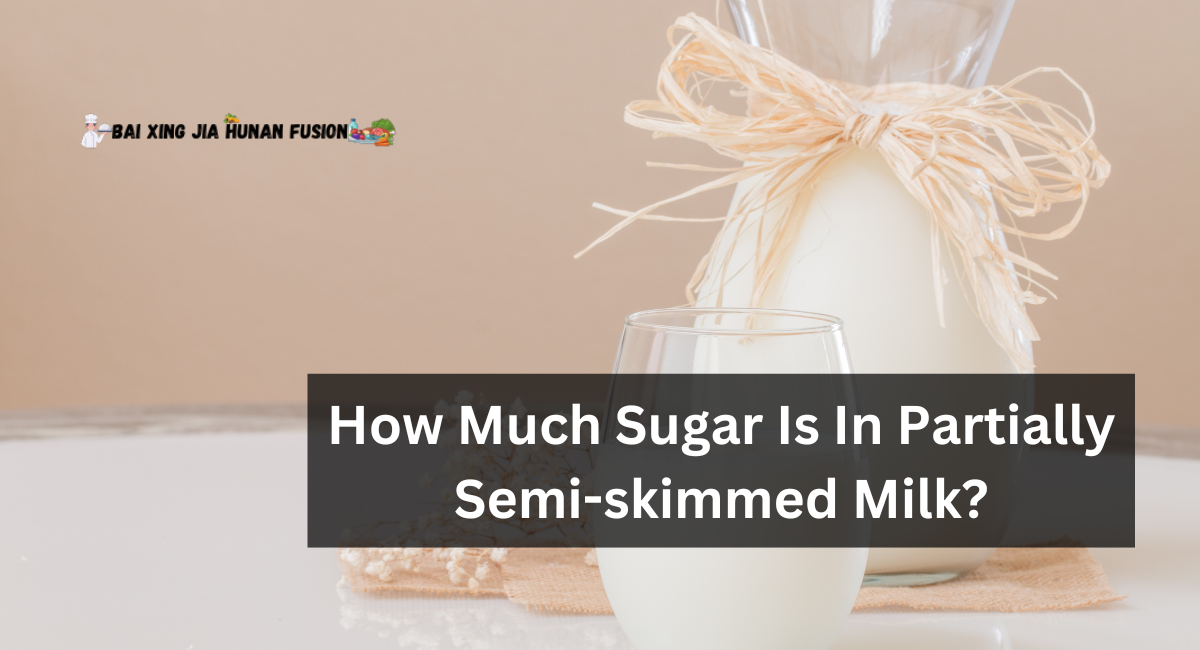In today’s health-conscious society, people are increasingly mindful of the foods they consume. Semi-skimmed Milk is an item that frequently elicits inquiries. Semi-skimmed Milk is widely regarded as a healthier alternative to whole Milk, but its amount of lactose remains a matter of debate. This article will discuss the amount of Sugar in semi-skimmed Milk.
Understanding Milk Types
Here are three type of milk
1. Whole Milk
Whole Milk, often called full-fat Milk, is exactly as the name suggests – it contains the entire amount of fat naturally present in cow’s Milk.
2. Semi-Skimmed Milk
Semi-skimmed Milk, also known as 2% milk, is a popular option for those who desire a balance between the creaminess of whole Milk and the low-fat content of skim milk.
3. Skim Milk
The leanest of the three varieties is skim milk, also known as fat-free Milk. It is subjected to a procedure that removes most of the Milk’s fat, resulting in Milk containing significantly less fat.
How Much Sugar And Fat Is In Semi-Skimmed Milk?
Approximately 11-12 grams of Sugar are present per cup of semi-skimmed Milk. This is primarily lactose, the natural sugar present in all milk types. However, flavored varieties may contain higher levels of Sugar due to added sweeteners; therefore, it is essential to examine labels for accurate information on sugar content.
1.8% Fat Content in Semi-Skimmed Milk
The fat in semi–skimmed Milk is 1.8%, while the amount in whole Milk is 3.5%. Most of the Milk in Northern Ireland is semi–skimmed Milk.
Semi–skimmed Milk contains fewer calories (95 calories per 200ml serving), less fat than whole Milk, and less vitamin A. The levels of other nutrients, such as protein, calcium, and vitamins B2 and B12, are not diminished.
What Does Sugar Do To Milk?
The Role of Lactose
Milk contains a natural substance known as lactose. Lactose consists of two sugar molecules, glucose, and galactose, and is in varying quantities in all milk varieties.
Added Sugars
Some semi-skimmed milk products on the market have added sweeteners for flavor enhancement. This ingredient can substantially increase the amount of Sugar in a food.
Factors Affecting Sugar Content In Semi-Skimmed Milk
The following variables largely determine the sugar content of semi-skimmed Milk:
- Lactose Content: Milk contains lactose, which is a natural sugar that is found in Milk. The amount of Sugar in semi-skimmed Milk is largely determined by the lactose content, which is relatively constant regardless of lipid content. Lactose concentration in Milk is typically between 4.8 and 5.2 grams per 100 milliliters.
- Processing and Fortification: Some commercial semi-skimmed milk products may be subjected to sugar-altering refining or fortification. For example, some brands may add sugars or sweeteners for flavor enhancement, increasing the sugar content.
- Milk Source: Due to variations in milk composition between species, the origin of the Milk, whether it comes from cows, goats, or other animals, can influence the sugar content marginally.
- Breeds and Diet of Dairy Animals: Within a given species, the breed and diet of dairy animals can affect the composition of Milk, including its sugar content. Some cow varieties may produce Milk with slightly varying levels of Sugar.
- Seasonal Variations: The sugar content of Milk can also differ seasonally depending on the diet of dairy animals. During certain periods of the year, when animals graze on fresh pasture, Milk may have a slightly different sugar profile than in the winter, when they consume stored feed.
- Heat Treatment: Milk may be subjected to thermal treatment, such as pasteurization or ultra-high-temperature (UHT) processing, which can influence the sugar content by promoting caramelization or other chemical reactions. Typically, however, these variations are minor.
- Storage Conditions: Milk’s flavor can be affected by its storage conditions, which may indirectly influence its sweetness. Maintaining Milk’s integrity with proper refrigeration.
- Added Ingredients: Some processed semi-skimmed milk products may have flavorings or additives such as chocolate, vanilla, or sweeteners added, which significantly increases the sugar content.
Health Benefits Of Semi-Skimmed Milk
Reduced Fat
In comparison to whole Milk, semi-skimmed Milk has a lower lipid content. This reduced fat content makes it an excellent choice for individuals seeking to reduce their overall fat intake while appreciating Milk’s nutritional value and flavor.
Essential Nutrients
Despite the fat reduction, semi-skimmed Milk remains a nutrient-rich dynamo. Calcium, which is important for healthy bones and teeth, is abundant in this food. Additionally, it provides a substantial quantity of protein, which is important for muscle development, repair, and general body function.
Weight Management
Semi-skimmed Milk can be a valuable ally for those concerned with weight control. It provides the satisfaction and health benefits of dairy without the greater calorie content of whole Milk. This can help individuals maintain a diet that is low in calories.
Cardiovascular Health
Due to its potassium and vitamin D content, semi-skimmed Milk contributes positively to cardiac health. These nutrients have been shown to modulate blood pressure and reduce the risk of cardiovascular disease.
Digestive Wellness
Milk, including semi-skimmed Milk, contains lactose, a natural sugar that facilitates digestion in individuals who do not have lactose intolerance. In addition, Milk is a source of probiotics, which can aid in developing and maintaining a healthy intestinal microbiome, thereby contributing to overall digestive health.
Versatility in Cooking
Semi-skimmed Milk is a versatile ingredient in the kitchen. Its reduced fat content makes it an ideal addition to various recipes, including smoothies, cereals, soups, and baked products. Semi-skimmed Milk can be your go-to dairy option, whether making a creamy sauce or savoring a bowl of cereal.
Nutrient Absorption
Semi-skimmed Milk contains a small amount of fat, which assists in the absorption of fat-soluble vitamins such as vitamin D and K. This ensures that your body effectively utilizes these essential nutrients for various physiological processes.
Thanks for visiting our site hope you like it …










